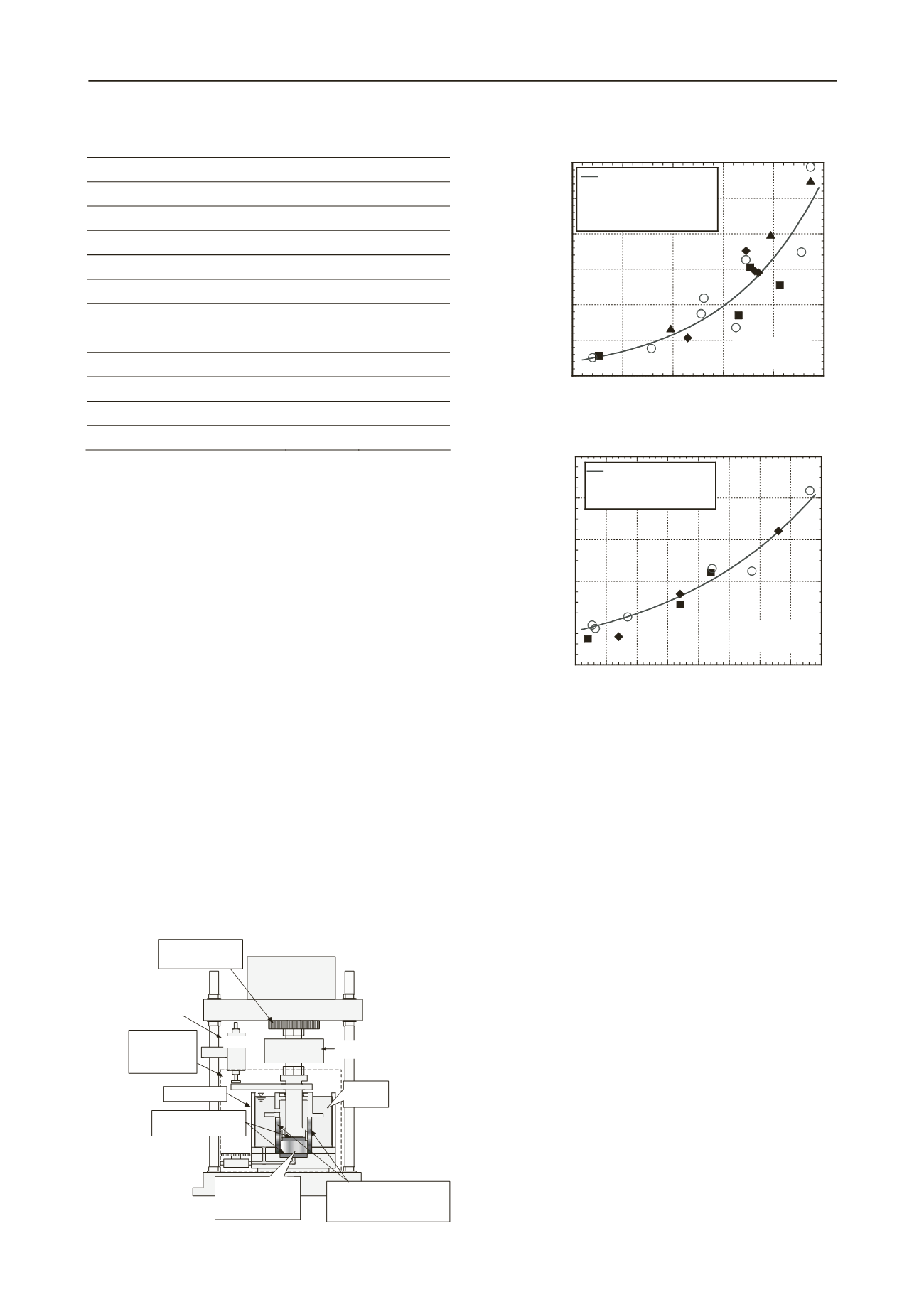
3368
Proceedings of the 18
th
International Conference on Soil Mechanics and Geotechnical Engineering, Paris 2013
After the bentonite heating described above, these samples
werekeptat a constant temperature (22 3°C) and constant
humidity (70% relative humidity) until the water contents of
samples stopped changing.
3 SWELLING PRESSURE AND SWELLING
DEFORMATION OF BENTONITES
AFTERSOMETHERMAL EXPOSURE
This study used the experimental apparatus presented in Fig.
2.The maximum capacity and the minimum scale of the load
transducer were 10 kN and 0.0025 kN, respectively. The
maximum capacity and the minimum resolution of the linear
variable displacement transducer (LVDT)were, respectively, 25
mm and 0.002 mm. This study conductedswelling characteristic
experiments of twokinds. The swelling pressure test measured
the bentonites’ swelling pressure as water was supplied to the
confined bentonite specimen. The swelling deformation test
measured the relationbetween the axial swelling deformation
and the time from the start of water supply. Test
proceduresweredescribed in an earlierarticle (Komine et al.,
2009).
Figure 3 portrays the relation between maximum swelling
pressure and the initial dry density of bentonites’ thermal
exposureduring swellingpressure tests. This figureshows that
the influence of thermal exposureon swelling pressure
characteristics of both bentonites is slight, provided that
theheating temperature is less than 130°C and that the heating
duration is less than 120 days.Regardingresultsobtained for
calcium-type bentonite C depicted in Fig. 3(b), almost no
influenceof
thermal
exposureon
swelling
pressure
characteristics is shown for1.37–1.53 Mg/m
3
initial dry density.
However, a slightinfluenceof thermalexposure is apparentat
1.22–1.27 Mg/m
3
.
0
1000
2000
3000
4000
5000
6000
1.4 1.5 1.6 1.7 1.8 1.9
Maximum swelling pressure, P
smax
(kPa)
Initial dry density,
d0
(Mg/m
3
)
○
: No heating
▲
: 60 degree, 28 days
◆
: 130 degree, 28 days
■
: 130 degree, 120 days
Bentonite A
(Kunigel-V1)
(a) Bentonite A
0
2000
4000
6000
8000
10000
1.2 1.25 1.3 1.35 1.4 1.45 1.5 1.55 1.6
Maximum swelling pressure, P
smax
(kPa)
Initial dry density,
d0
(Mg/m
3
)
○
: No heating
◆
: 130 degree, 28 days
■
: 130 degree, 120 days
Bentonite C
(Kunibond)
(b) Bentonite C
“No heating” in the legend denotes experimentally obtained results for
bentonite with no thermal exposure. The temperature in the legend is
the heating temperature by dryingoven. The days in the legend show
the heating duration.
Figure 3. Relationbetween maximum swelling pressure and initial dry
density of bentonites A and B withthermal exposure.
Table 1. Fundamental properties of bentonites A and C
Bentonite
A
C
Type
Sodium
Calcium
Density of soil particle(Mg/m
3
)
2.79
2.71
Liquid Limit (%)
458.1
128.7
Plastic Limit (%)
23.7
38.4
Plasticity index
434.4
90.3
Montmorillonite content (%)
57
84
Cation Exchange Capacity (meq/g)
1.166
0.795
Exchange Capacity of Na
+
(meq/g)
0.631
0.119
Exchange Capacity of Ca
2+
(meq/g)
0.464
0.585
Exchange Capacity of K
+
(meq/g)
0.030
0.019
Exchange Capacity of Mg
2+
(meq/g)
0.041
0.072
Figure 4 shows the relation between maximum swelling
strain and initial dry density of sodium-type bentonite A at
vertical stresses of 1000 kPa and 500 kPa. Results in this
figureshow that maximum swelling strain increases linearly as
theinitial dry density increases. For the sodium-type bentonite A,
the swelling deformation property of bentonite after thermal
exposure is almost unchangedunder 1000 kPa vertical stress.
However, the swelling deformation property of bentonite
isgreatlyreduced for heating at 90–130°C fora 365-day heating
duration under conditions of 500 kPa vertical stress, as
portrayed in Fig. 4(b). Those results indicate that the thermal
influence to swelling deformation characteristics of sodium-type
bentonite A is dependent onthe vertical stress condition. The
influences of thermal exposureon swellingdeformation decrease
for high vertical stresssuch as 1000 kPa. Thisdiscussion shows
agreement with previously presenteddiscussionindicating that
swelling pressure characteristics of bentonite Ashowalmost no
change according to thermal exposure, as depicted in Fig. 3(a)
and previously reportedexperimentally obtained results
(Komine and Ogata, 1998) showing thatswelling deformation
Load
transducer
Distilled
water
Compressed air
cylinder for
loading
Clamp for fixing
the piston
LVDT
Porous metal and
nonwoven filter
Acrylic cell
Swelling cell
(Inside of
broken lines)
Specimen
Diameter 28 mm
Height 10 mm
316L stainless steel ring
Inner diameter 28 mm
Height 50 mm
Maximum capacity = 10 kN
Minimum scale = 0.0025 kN
Maximum capacity = 25 mm
Minimum scale = 0.002 mm
Figure 2. Experimental apparatus.


